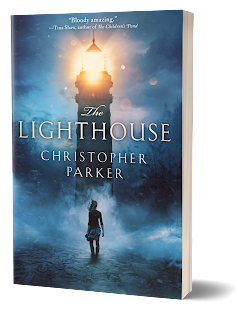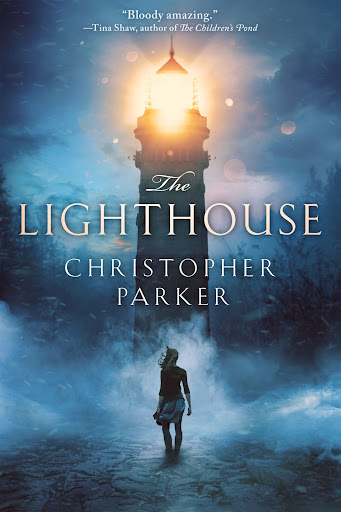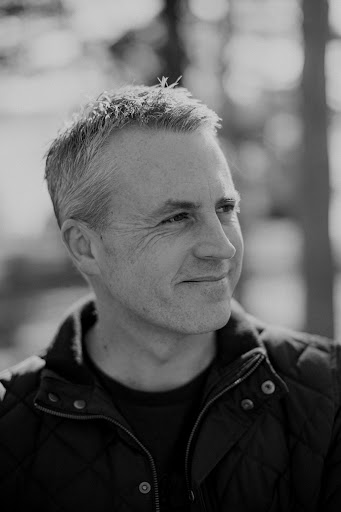Compelling contemporary novel filled with hope, renewal and a touch of magic
 Auckland, NZ – After spending nearly 10 years writing, editing, and dreaming, Christopher Parker is making his authorial debut with a page-turning book flowing with love, suspense, mystery, and whimsy. Originating from a short story he created as a child, the result of Parker’s decadelong mission to produce the book has come to fruition with “The Lighthouse” (Oct. 26, 2021, Beacon Press Limited).
Auckland, NZ – After spending nearly 10 years writing, editing, and dreaming, Christopher Parker is making his authorial debut with a page-turning book flowing with love, suspense, mystery, and whimsy. Originating from a short story he created as a child, the result of Parker’s decadelong mission to produce the book has come to fruition with “The Lighthouse” (Oct. 26, 2021, Beacon Press Limited).
Motivated by the birth of his daughter and to fulfill his lifelong dream of drafting a full-length novel, Parker was inspired to write a story like no other, focusing his time on the craft of storytelling and the importance of his characters. Leaving no stone unturned, his devotion to his craft is reflected in his writing, his attention to detail, and the emotional development of his two main characters in a book that fellow New Zealand author Tina Shaw has deemed, “Bloody amazing.”
The thrilling story follows Amy, a young woman grieving the loss of her mother, and Ryan, a young ranch hand whose ardent love for his father drives him to continue running his family’s failing business. When Amy first visits Seabrook, Oregon, she’s immediately fascinated by the beautiful coast and its ghostly past. And while her first impressions of Ryan aren’t the most flattering, their friendship forms deeper bonds as the truth behind the town lighthouse and its supernatural aura emerge.
The two, coming of age and filled with hopeful renewal, embark on an unexpected journey to find the truth, each other, and most importantly, themselves. Parker’s dazzling debut is sure to captivate readers with an unexpected story that will surprise and charm on every page.
“The Lighthouse”
Christopher Parker | Oct. 26, 2021 | Beacon Press Limited | Fiction
Paperback | 978-0-9951495-0-2 | $15.99 | Ebook | $5.99
 Something strange is happening in Seabrook. The town’s lighthouse–dormant for over thirty years and famously haunted–has inexplicably started shining, and its mysterious glow is sparking feverish gossip throughout the spooked community.
Something strange is happening in Seabrook. The town’s lighthouse–dormant for over thirty years and famously haunted–has inexplicably started shining, and its mysterious glow is sparking feverish gossip throughout the spooked community.
Amy Tucker is only visiting for the night and has no plans to get caught up in the hysteria, but that changes when she meets Ryan, the loyal, hard-working son of a ranch owner who lives on the outskirts of town.
Their chance encounter turns into an unforgettable weekend, and against the backdrop of the lighthouse-obsessed town, the two of them forge a deep connection, opening their hearts, baring their souls, and revealing secrets long kept hidden.
But as they grow closer, and as the lighthouse glows ever brighter, a startling discovery about Ryan leaves Amy questioning everything she thought she knew. To uncover the truth about her new friend, Amy will need to enter Seabrook’s ominous tower, where waiting inside she will not only find the reason why fate has brought them together… but a shocking secret that will change the course of their lives forever.
“This smart, suspenseful, and briskly paced work will keep readers guessing. … a haunting but hopeful work of supernatural fiction that comes to a satisfying conclusion.” — Kirkus Reviews
Praise for Christopher Parker and “The Lighthouse”
 “Bloody amazing … ‘The Lighthouse’ will have you laughing then weeping.
“Bloody amazing … ‘The Lighthouse’ will have you laughing then weeping.
I couldn’t put it down.” — TINA SHAW, author of “The Children’s Pond”
Christopher Parker was born in Takapuna, a seaside suburb in Auckland, New Zealand, where he currently lives with his daughter. Having loved writing stories growing up, it was a walk along Takapuna beach and a chance glimpse at a distant lighthouse that made him want to revisit his childhood passion and try his hand at producing a novel. Nearly 10 years on from that fateful stroll, he is proud to finally share his story. You can find him on his website at https://www.christopherparker.com.
Follow Christopher Parker
on social media: Facebook | Twitter | Instagram
In an interview, Christopher Parker can discuss:
- The book’s journey from short story to a full-length novel
- His motivation and writing process over the past 10 years
- Tackling themes of grief and loss and the hopefulness the book leaves with readers
- Developing his characters and crafting the the fictional town of Seabrook, Oregon
- The use of magical realism and mystery to set the book’s tone
- The incorporation of the lighthouse and its eerie effects
- Projects he’s working on next
An Interview with Christopher Parker
1. “The Lighthouse” is an exceptional story that took you nearly 10 years to finish. Where did it all begin and how did the timeline of the process progress?
It began somewhat naively. I had the idea for the story I wanted to tell, I calculated how many words I could write per day, and I figured I could be done in three months. The first draft ended up taking three years and it was awful. It was overwritten and full of subplots that went nowhere. I then began reading as widely and voraciously as I could, determined to learn and understand more about the craft, and I started the manuscript again from scratch. The second draft took a further three years, followed by another couple of years of editing and revision. Had I known what was involved at the beginning, I’m not sure I would’ve begun!
2. What was your motivation to keep writing all these years?
I believed in the story so much that I had no choice but to see it through to the end. At times I felt very much like a sailor lost at sea — too far from home to quit but no sight of a destination either. I had no choice but to just keep sailing. It did me no good to plot an end date or to try and hurry along the process. My only approach was to do my best every day, keep making progress and moving forward. As long as I did that, then I knew that one day I would find myself at the finish line.
3. While you’re from New Zealand, you set your book off the coast of Oregon. Is there any significance with choosing this setting?
This was a decision made early in the process, mostly because the characteristics of the story lent to a North American setting. Ryan lives and works on a ranch, and Amy (in the first draft of the book) was a swimmer on a college scholarship — both these elements felt more quintessentially “American” than New Zealand. As for Oregon, that choice was driven by the needs of the story, too. It was important that the fictional town of Seabrook be situated in a picturesque landscape where a haunted lighthouse wouldn’t be out of place, and Oregon’s beautiful, dramatic coastline was the ideal setting.
4. How did you come up with Amy and Ryan? Are they inspired by anyone in your own life?
Amy and Ryan aren’t inspired by anyone in particular. The idea began with the concept of the lighthouse and then the characters were brought to life to serve the building’s pivotal role in the story. However, once I began writing Amy and Ryan and spending time with them, they took on a life of their own and I became quite attached. Over the years, they’ve become like extended members of the family. Even though the story has been written, I still think about them often and know everything that happens after the final page.
5. What were some of your personal goals with writing this story?
To finish the thing! On a personal level, I simply wanted to do the best job I could and publish something my daughter could one day look back on and be proud to say, “My dad wrote that.” The book is dedicated to her, and she’s the reader I want to impress the most.
6. Without any spoilers, can you talk about the significance of the lighthouse?
I’ve always been fascinated by lighthouses and long admired them. It was never my intention to write a novel featuring one, but when I thought up the central idea of the story, there was no other building better suited to play the part. There is also an obvious strong echo between a lighthouse’s role in being a guiding light for sailors out at sea and the part it plays in being a beacon for Amy and Ryan. In my story, it is a symbol of light and hope, both literally and metaphorically.
7. One of the major themes in the book is Amy’s process of grieving her mother. Why was it important to include themes of grief and loss?
I think, like everyone, I am intrigued by the concept of death and the eternal question of what ultimately becomes of us. The book does deal with grief and loss, but more than that, I believe “The Lighthouse” is a story about love — not just the love that exists between two young people who are fatefully thrown into each other’s lives but also the kind of love that exists between a grieving husband and his wife, as well as that unconditional, unshakeable bond of love that exists between parent and child. I believe love is more than a fleeting emotion or just a chemical reaction in the brain. To me it’s a tangible part of the human spirit that endures long after we’re gone. “The Lighthouse” is an exploration of those ideas.
8. What was the biggest challenge you faced while writing the book?
Being able to step back from the story. When you’re deep in the process of writing, it’s difficult to look at it objectively and ask the tough questions: Does this scene need to be here? Does this conversation serve the story? Is this choice consistent with the character? I’ve had to cull hundreds of thousands of words — some of them I was quite proud of — simply because they didn’t serve the arc of the story or add anything to the journey of the characters. It’s a painful, challenging skill to learn, and I’m not sure I’ve even mastered it, but I believe it’s something every writer must do if they’re to create an engaging, fulfilling story for the reader.
9. What are some surprising things you’ve discovered self-publishing your novel?
Just how challenging it can be to know when it’s time to let go. When you’re publishing traditionally, you’ll likely have a deadline, but when you’re self-publishing you’ve got all the time in the world, which can be a blessing but also a curse. It can be very tempting to get stuck in a loop of getting feedback and making tweaks to the manuscript in the hope that you’ll be able to create something that pleases everyone. But that’s never going to be possible. There’s a fine line between making improvements and editing the life out of the story, and at some point, you need to know when enough is enough.
10. Why is “The Lighthouse” such an important story to you? What do you hope readers gain from the book?
It’s important to me because it’s the exact kind of book I’d like to pick up and read — a story that takes readers on an exciting, unexpected ride and has a bit of everything: mystery, love and a touch of magic. I just hope readers are entertained and that the themes and ideas explored in the story resonate with people.
11. What projects are you working on next?
I have the rough outline of the next novel sketched out, and in the meantime (while getting “The Lighthouse” ready for publication) I wrote a children’s story about a troublesome dog that’s being illustrated now. That only took a month to write, and I found the process refreshingly easier than the gargantuan task of completing a full-length novel. I am, however, looking forward to immersing myself in the next one.

A former award-winning journalist with national exposure, Marissa now oversees the day-to-day operation of the Books Forward author branding and book marketing firm, along with our indie publishing support sister company Books Fluent.
Born and bred in Louisiana, currently living in New Orleans, she has lived and developed a strong base for our company and authors in Chicago and Nashville. Her journalism work has appeared in USA Today, National Geographic and other major publications. She is now interviewed by media on best practices for book marketing.
